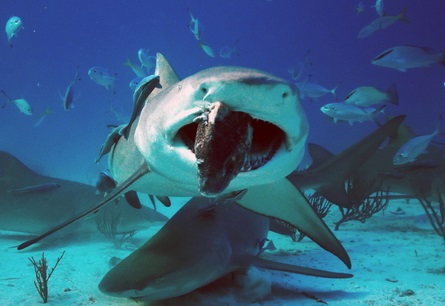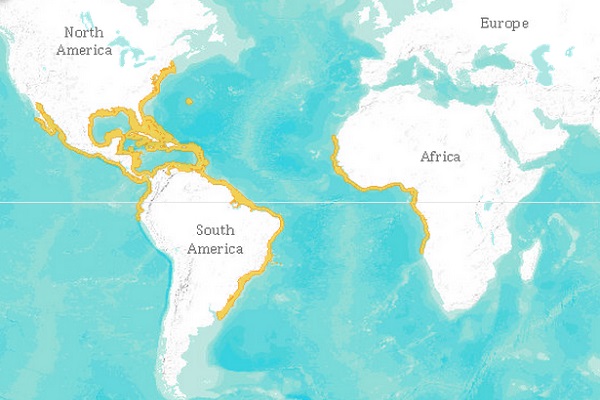0
Taxonomy

Lemon shark at the Oregon Coast Aquarium. This species is considered near threatened by the IUCN Red List of Threatened Species
- Kingdom: Animalia
- Phylum: Chordata
- Class: Chondrichthyes
- Order: Carcharhiniformes
- Family: Carcharhinidae
- Genus: Negaprion
- Species: Negaprion brevirostris
0
Name
- Scientific Name: Negaprion brevirostris.
- Common Name: Lemon shark.
Distribution and Habitat
- They inhabit the coastal inshore waters of the northwest Atlantic Ocean from the coast of the state of New Jersey to Southern Brazil, the Caribbean and the Gulf of Mexico.
- They also inhabit the east coast of the Pacific Ocean from Baja California to Ecuador.
- The lemon shark’s distribution also extends to the east Atlantic Ocean from the coast of Senegal to Ivory Coast in East Africa.
- They stay within coastal areas unless they are migrating.
- They inhabit rocky or sandy surfaces in shallow waters up to 295 feet or 90 meters deep. They can be found in mangroves, coral reefs, river mouths and enclosed bays. They have a well defined home range.

Range of the lemon shark. Source: IUCN Red List of Threatened Species
Physical Features
- Their torso coloration varies from olive green to yellow brown.
- They get their name from the yellow coloration of their belly.
- Lemon sharks are large and stocky fish. They have round and short snouts.
- They have two dorsal fins. The posterior is shorter than the anterior one. They have one pectoral and one pelvic fin.
- Males are larger than females.
- They have poor vision but a strong sense of smell.
- They rely on electro-receptors called ampullae of Lorenzini.
Length and Weight
- The average length of an adult lemon shark is 8.2 to 9.5 feet or 2.5 to 2.9 meters, up to 9.8 feet or 3 meters in length. They can weigh up to 551 lbs or 250 kg.
Behavior
- The lemon shark is a migratory species, though migration patterns have not been studied.
- They hunt at night using their acute sense of smell and electro-receptors to find their prey. Prey produces bioelectrical fields from muscle contractions which is captured by the shark’s electro-receptor system. This system is located at the underside of their head, snout and nose and it is called ampullae of Lorenzini.
- They have been seen congregating near fishing piers and docks.
- They are social animals who spend their time in loose aggregations.
Diet
- They are carnivores and eat mostly mollusks, bony fish, crustaceans, sea birds and smaller sharks.
- Adults occasionally eat younger sharks.
Reproduction
- Males reach reproductive maturity when they are 88.5 inches or 225 cm while females when they are 96.5 inches or 245 cm. This is at around 6 to 7 years of age.
- Lemon sharks mate in the spring and summer months.
- Females are polyandrous. Her eggs are fertilized by the sperm of multiple males.
- Lemon sharks are viviparous. Unlike most fish where the female lays eggs to be fertilized by the male, the eggs of the lemon shark are fertilized inside her body. The embryos nourish from a placenta and hatch within the mother’s body giving birth to life pups.
- Gestation period is from 10 to 12 months.
- They give birth from 4 to 17 young and after that it takes a year before they mate again.
- Female lemon sharks return to the same nursery after giving birth.
The young
- At birth pups are from 24 to 26 inches or 60 to 65 cm long.
- Juveniles stay in the nursery, a save area, where they were born for two to three years. This area has shallow waters of up to 50 cm.
- Mortality rate among pups is from 35 to 62% due to predation.
Life Expectancy
- Lemon sharks live up to 25 years in captivity and up to 30 years in the wild.
Threats
- Lemon sharks are caught commercially and are widely consumed.
- Adult lemon sharks have no known predators.
Conservation Status
- The IUCN Red List of Threatened Species considers the lemon shark as a “Near Threatened” species.
- There is no management plan for the conservation of the lemon shark.
References and Further Research
IUCN Red List of Threatened Species – Negaprion brevirostris
University of Michigan Museum of Zoology – Negaprion brevirostris Galano
Ichthyology at the Florida Museum of Natural History
U.S. National Library of Medicine – Semiconductor gel in shark sense organs?
